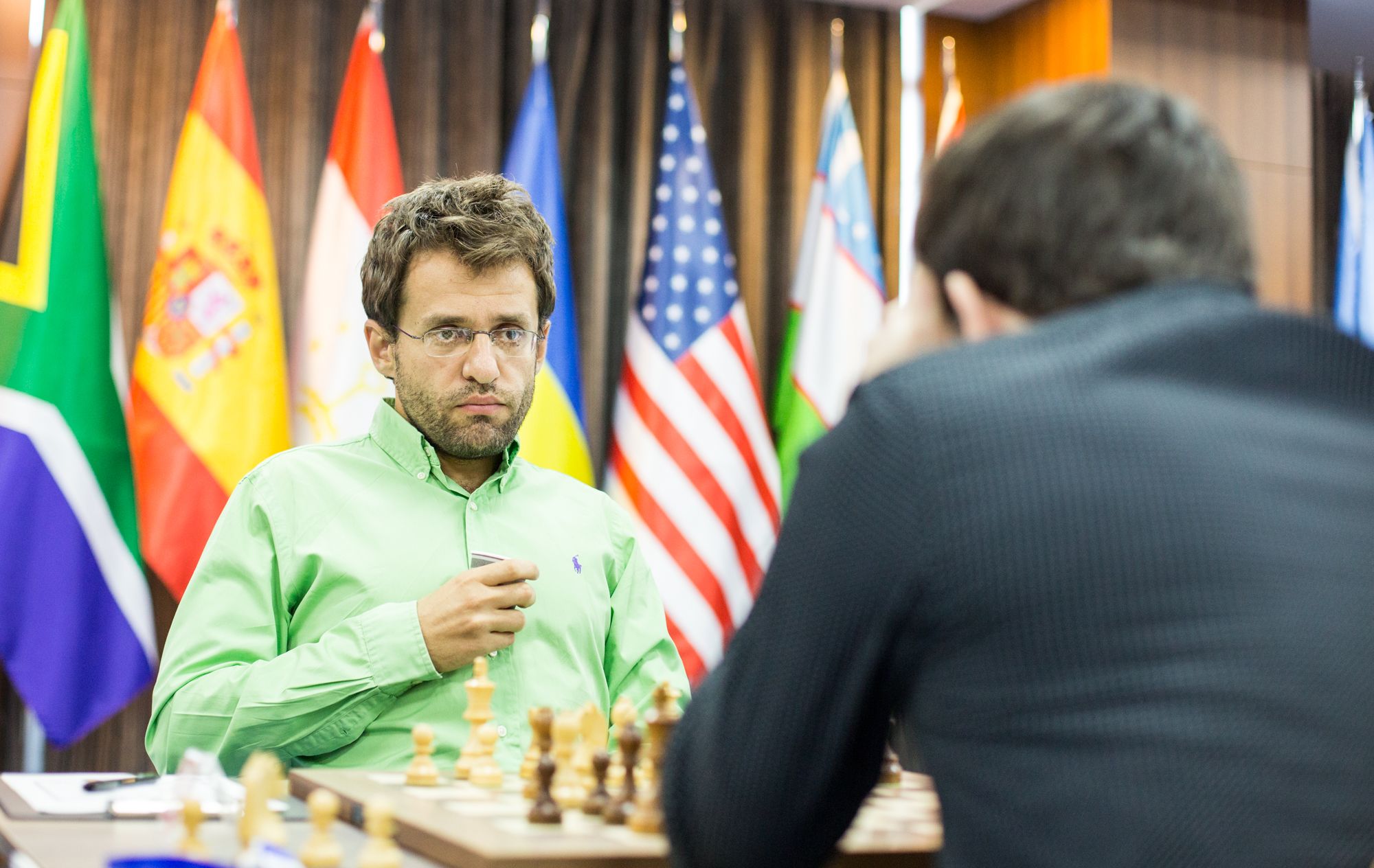
World Cup Semifinals: Was So Winning?
Both games on the first day of the FIDE World Cup's semifinals were drawn. Levon Aronian and Maxime Vachier-Lagrave split the point quickly in a very theoretical line of the Gruenfeld Defense. Wesley So built up serious pressure vs Ding Liren in an Italian game, but allowed a move repetition just after the time control.
Wesley So leaving the playing hall after drawing a good position. | Photo: Chess.com/Maria Emelianova.
Only four players are left in the tournament, but the most important matches have started. At stake are two tickets for the 2018 Candidates' Tournament, announced to be held in March in Berlin.
This is the last match where only two classical games are played, and then if needed, a tiebreak. The final will see four classical games. Under tremendous pressure to reach their coveted result, four top grandmasters from Armenia, France, the U.S. and China have started their biggest fight of the year.
2017 World Cup | Results Semifinals
| Fed | Player | Fed | Player | Classical | Rapid | Blitz | Score |
| Aronian (2802) | Vachier-Lagrave (2804) | ½-½ | ½-½ | ||||
| So (2792) | Ding Liren (2771) | ½-½ | ½-½ |
It's the pressure the players are under that might explain not the results of the two games, but the way these draws were reached. Because in both cases, they left some questions.
Starting with Levon Aronian vs Maxime Vachier-Lagrave, one may wonder why Aronian went for a theoretical line that is known to be analyzed till exhaustion, and evaluated as drawn. One may also wonder why his theoretical novelty on move 24 simply dropped a pawn.

Aronian clearly mixed up his preparation today. | Photo: Chess.com/Maria Emelianova.
It was the famous 8.Rb1 variation of the Gruenfeld that we're talking about; a line that was introduced in 1975 but only really caught on at the highest level from 1990 onwards. Boris Gelfand was the main warrior from the white side in those early days, whereas Vassily Ivanchuk and Gata Kamsky tried it successfully as Black.
Time has moved on, and theory has moved on tremendously. This variation is one of the corners in chess theory that few white players pay a visit these days. It's all been worked out. Black is OK.
One of the top players who has proven this in recent times is Peter Svidler, who was just eliminated by MVL in the quarterfinals. He was "still there" today in Tbilisi, because if you look at the database after 18 moves, it's kind of "his" variation.
Svidler was also involved in an entertaining Twitter chat during the game.

Vachier-Lagrave on the opening: "I was for the most part aware of the developments in this line and when Levon played 24.Rbc1 I was surprised by it because it just seems to blunder a pawn. I'm not sure what he confused; whether he just forgot something. I could take the pawn and the only question is whether I was better."
It's not that Aronian could have been surprised about MVL's opening play. It's the Frenchman's main black weapon, and if you go 8.Rb1, the rest of the game is basically the main line. Blundering a pawn like that can only be explained by the grueling tournament format, and the stakes.
"After that I might even have played a bit too conservatively," said Vachier-Lagrave. "I mean, it's an easy draw but I could even put him under some pressure with for instance 25...Bc5 instead of 25...Qb4 but it was a very strange experience to adapt to this because normally you just don't get a pawn for free and it's still probably equal but of course it was a bit of a strange game."

MVL: "It was a bit of a strange game." | Photo: Chess.com/Maria Emelianova.
FIDE's Nastja Karlovich said that Aronian confirmed that he had blundered on move 24. MVL: "I assumed it was some sort of preparation but then after 25.Qc3, and he played all these moves without thinking, I realized, no, it must not have been been preparation. He's right in the sense that it should still be within drawing margin."

Aronian vs MVL, a match between two good friends. | Photo: Chess.com/Maria Emelianova.
In the other game, one gets the impression that Wesley So might have won vs Ding Liren if it had been in a regular tournament situation—on a day like most other days, where nobody is thinking about candidates or world championship cycles.
"I think I was pressing for the most part," said So, who by the way thought that MVL had White today. He expected to see two Giuoco Pianos!

An Italian Game in So vs Ding, but not in the other game. | Photo: Chess.com/Maria Emelianova.
"He offered a draw on move 14 but I wanted to play a few more moves. Then I found this idea 18.Qb5 and he took on b5; maybe there was no need for that."
As So explained, White's new pawn structure led to a more pleasant position because of the space advantage, and the nice outpost on d5 for a knight.
"But then he just played 32...f6 and put the king on d7, a very wise decision to keep his queenside pawns defended because his pawn on a4 is slightly overextended," explained So. He had a few "sophisticated ideas" (Kd2-c3 and somehow play Ra1 and b4, or double rooks on the a-file) but he couldn't get them to work.
"The tactics work very well for him and there was no way for me to push the position."
So did look at the exchange sacrifice that could have occurred on move 40. After reaching the time control, he only spent three minutes calculating it. "The problem is I don't have time for Rg7 because he has counterplay on the second rank with Rh2/Ra2," he said. "I have to spend moving my king with Kc3 and then he has no counterplay but he defends on the seventh rank with Rh7 and he loses his f- and the pawn on b3. Then I have two pawns for the exchange and a very nice position but I don't think White can make progress anyhow because my b-pawns are doubled. If they are not doubled maybe I have good chances."

Was Wesley So winning today? | Photo: Chess.com/Maria Emelianova.
So acknowledged that he could have waited a bit with pushing g4-g5, a suggestion that was also made by commentator GM Evgeny Miroshnichenko. All in all, the American GM shouldn't be thinking too much about this one. The more time he'll spend on it, the closer he might come to finding a win.
Meanwhile, Ding probably regrets swapping the queens like he did, and underestimating White's chances after that, although he played quite well in the remainder. And his "Rubinstein Maneuver" Qd8-b8-a7 was of course quite pretty too—reminiscent of the classic Janowsky-Rubinstein, Karlsbad 1907.

(Click for bigger version.)
Games from TWIC.
The World Cup takes place September 3-27 in Tbilisi, Georgia. Each round consists of two classical games (four in the final), and possibly a rapid and blitz tiebreak on the third day. The total prize fund is $1.6 million, including a first prize of $120,000. The top two finishers will qualify for the 2018 Candidates' Tournament.
Chess.com relays the games at Chess.com/Live. You can watch also live commentary on Chess.com/TV provided by the Chessbrahs, which includes some of the best commentators on the planet: GM Eric Hansen, GM Robin van Kampen, GM Yasser Seirawan and IM Aman Hambleton.
Previous reports:
- Vachier-Lagrave Knocks Out Svidler At World Cup
- Win With White; Draw With Black; Aronian, So, Ding Advance
- Ivanchuk Implodes On 1st Day Quarterfinals
- Fedoseev, MVL, Rapport, So, Svidler To Quarterfinals
- Aronian, Ding Liren, Ivanchuk Through To Quarterfinals
- Ivanchuk, Fedoseev Start Round 4 With Wins
- Caruana, Li Chao, Nepomniachtchi Leave World Cup
- World Cup Shock: Carlsen, Kramnik, Nakamura Out
- Bu Brilliancy Beats Carlsen At World Cup
- Dress Code Incident At World Cup: Kovalyov Forfeits
- Harikrishna, Mamedyarov, Radjabov, Wei Yi, Wojtaszek Exit World Cup
- Favorites Falter: Adams, Anand, Karjakin Knocked Out
- Anand Starts With Loss In World Cup Round 2
- Amin, Howell, Fressinet, Nisipeanu Exit World Cup
- Lenderman Knocks Out Eljanov At World Cup
- Eljanov, Fedoseev, Harikrishna, Wei Yi Upset At World Cup
- Carlsen Draws White For 1st Game World Cup
- FIDE World Cup To Start This Weekend
- Carlsen At The World Cup: 'I Want To Exploit This Loophole'
- Magnus Carlsen To Play FIDE World Cup



